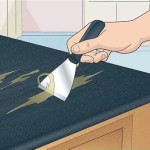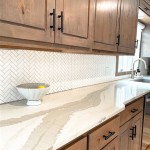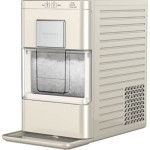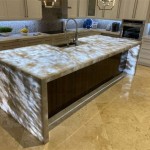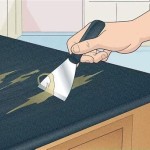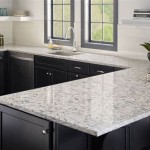What Paint to Use on Countertops: A Comprehensive Guide
Transforming countertops with paint offers a budget-friendly alternative to complete replacement, allowing for a refreshed aesthetic without the significant expense of new materials. However, the success of a painted countertop hinges heavily on selecting the appropriate paint and applying it correctly. The demands placed on countertop surfaces, including resistance to moisture, heat, and abrasion, require a durable and specialized coating.
This article explores various paint options suitable for countertop applications, detailing their characteristics, advantages, disadvantages, and proper application techniques. Evaluating these factors is crucial for achieving a long-lasting and visually appealing finish.
Understanding Countertop Paint Requirements
Before delving into specific paint types, it's vital to understand the environmental demands a countertop finish must endure. Countertops are exposed to frequent use, potential liquid spills, varying temperatures (especially near stoves or ovens), and cleaning products. Therefore, any selected paint must demonstrably meet these challenges.
Durability: Countertop paint must withstand daily wear and tear, including scratches, scuffs, and impacts from objects placed upon it. A durable finish resists chipping and peeling, maintaining its integrity over time.
Water Resistance: Countertops are regularly exposed to water and other liquids. The paint must be water-resistant to prevent absorption, staining, and potential damage to the underlying surface. A non-porous finish is essential.
Heat Resistance: Countertops near heat sources, such as stoves, require a paint that can withstand elevated temperatures without blistering, discoloration, or softening.
Cleanability: Countertops need to be easily cleaned and sanitized. The paint finish should be resistant to common household cleaning agents and allow for easy removal of spills and stains.
Adhesion: The paint must adhere strongly to the existing countertop surface. Proper surface preparation is crucial for ensuring optimal adhesion and preventing the paint from peeling or bubbling.
Epoxy Resin Coatings
Epoxy resin paints are a leading choice for countertop refinishing due to their exceptional durability, chemical resistance, and glossy finish. These paints are typically two-part systems consisting of a resin and a hardener that, when mixed, create a chemical reaction resulting in a hard, durable surface.
Advantages:
Epoxy coatings offer superior durability, making them highly resistant to scratches, stains, and impacts. Their chemical resistance allows for easy cleaning with a wide range of cleaning products without damaging the finish. Epoxy creates a smooth, glossy, and non-porous surface, effectively sealing the countertop against moisture. Many epoxy systems are designed for food contact surfaces, making them safe for kitchen countertops.
Disadvantages:
Epoxy application requires precise mixing ratios and careful application techniques. Errors in mixing or application can lead to curing problems and a compromised finish. The curing process often involves strong odors, requiring adequate ventilation. Epoxy coatings can be more expensive than other paint options. Epoxy can be susceptible to yellowing over time, especially when exposed to UV light.
Application:
Surface preparation is paramount. The countertop should be thoroughly cleaned, sanded to create a textured surface for adhesion, and primed with an epoxy primer. The two-part epoxy resin and hardener must be mixed according to the manufacturer's instructions. Apply the epoxy in thin, even coats using a brush or roller. Multiple coats may be necessary to achieve the desired thickness and coverage. Allow each coat to cure completely before applying the next. Safety precautions, including wearing gloves and a respirator, are essential during application.
Acrylic Polyurethane Paints
Acrylic polyurethane paints provide a durable and versatile option for countertop refinishing. These paints combine the flexibility of acrylics with the hardness and durability of polyurethanes, resulting in a tough and long-lasting finish.
Advantages:
Acrylic polyurethanes offer excellent durability and resistance to scratches, scuffs, and stains. They provide good water resistance, making them suitable for use in kitchens and bathrooms. These paints are available in a wide range of colors and finishes, allowing for customization. Acrylic polyurethanes are generally easier to apply than epoxy coatings. They offer good UV resistance, minimizing the risk of yellowing over time.
Disadvantages:
Acrylic polyurethanes are not as chemically resistant as epoxy coatings and may be susceptible to damage from harsh cleaning products. They are not as heat resistant as epoxy, and care should be taken to avoid placing hot items directly on the painted surface. Multiple coats are typically required to achieve adequate durability and coverage. Surface preparation is still crucial for proper adhesion and a long-lasting finish.
Application:
The countertop should be thoroughly cleaned, sanded, and primed with an acrylic primer. Apply the acrylic polyurethane paint in thin, even coats using a brush, roller, or sprayer. Allow each coat to dry completely before applying the next. Two to three coats are typically recommended for optimal durability. A clear polyurethane topcoat can be applied for added protection and shine.
Specialty Countertop Painting Kits
Several manufacturers offer all-in-one countertop painting kits designed specifically for refinishing countertops. These kits typically include all the necessary materials, such as paint, primer, sealer, and application tools, along with detailed instructions.
Advantages:
Countertop painting kits provide a convenient and comprehensive solution for countertop refinishing. They are often easier to use than individual paint products, especially for beginners. The kits are designed to work together, ensuring compatibility and optimal performance. They typically include detailed instructions, simplifying the application process. The selection of colors and finishes offered in kits are designed to mimic the look of natural stone or other popular countertop materials.
Disadvantages:
Countertop painting kits may be more expensive than purchasing individual paint products. The color and finish options may be limited compared to using individual paint products. The quality of the materials in some kits may vary, potentially affecting the durability and longevity of the finish. The instructions provided in some kits may not be detailed enough for all situations. Surface preparation is still crucial for proper adhesion and a long-lasting finish, even when using a kit.
Application:
Follow the manufacturer's instructions carefully. Surface preparation is paramount and typically involves thorough cleaning, sanding, and priming. Apply the paint according to the instructions, ensuring even coverage and proper drying times between coats. Apply any included sealer or topcoat for added protection and durability. Allow the countertop to cure completely before use.
Surface Preparation: The Cornerstone of Success
Regardless of the paint chosen, meticulous surface preparation is non-negotiable for a successful and enduring countertop refinishing project. Inadequate preparation will invariably lead to adhesion failures, peeling, and premature wear.
Cleaning: Thoroughly clean the countertop to remove any grease, dirt, or grime. Use a degreaser or a strong cleaning solution specifically designed for the existing countertop material. Rinse thoroughly and allow the surface to dry completely.
Sanding: Sand the entire countertop surface to create a textured surface for the paint to adhere to. Use medium-grit sandpaper (120-180 grit) for the initial sanding, followed by fine-grit sandpaper (220-320 grit) to smooth the surface. Pay close attention to edges and corners. Remove all sanding dust with a tack cloth or a vacuum cleaner.
Priming: Apply a primer specifically designed for the existing countertop material and the chosen paint. The primer helps to seal the surface, improve adhesion, and create a uniform base for the paint. Follow the manufacturer's instructions for application and drying times.
Repairing Imperfections: Fill any cracks, chips, or imperfections with an appropriate filler or patching compound. Allow the filler to dry completely and sand smooth before priming.
Additional Considerations
Color Selection: Choose a color that complements the surrounding décor and provides the desired aesthetic. Consider the existing color scheme of the kitchen or bathroom and select a color that harmonizes with it.
Finish Selection: Consider the desired finish, such as matte, satin, or gloss. Glossy finishes are easier to clean but may show scratches more easily. Matte finishes are more forgiving but may be more difficult to clean. Satin finishes offer a balance between the two.
Sealers and Topcoats: Apply a sealer or topcoat for added protection and durability. Sealers and topcoats help to protect the paint from scratches, stains, and moisture. Choose a sealer or topcoat that is compatible with the chosen paint.
Cure Time: Allow the paint to cure completely before using the countertop. The curing time varies depending on the type of paint and the environmental conditions. Follow the manufacturer's instructions for curing times.
Maintenance: Clean the countertop regularly with a mild detergent and water. Avoid using harsh cleaning products or abrasive cleaners. Use cutting boards and trivets to protect the countertop from scratches and heat.

I Painted My Kitchen Countertops Ugly Duckling House

How My Painted Countertops Look After 3 Years Of Use

Rustoleum Countertop Transformation Paint Review One Year Later Lindi Russ

How My Painted Countertops Look After 3 Years Of Use

Countertop Coating Rust Oleum

How To Paint Laminate Countertops

How My Painted Countertops Look After 3 Years Of Use

What Kind Of Paint Do You Use On Countertops The Countertop Factory

I Painted My Kitchen Countertops Ugly Duckling House

Paint Granite Countertops To Look Like Marble Jennifer Rizzo

